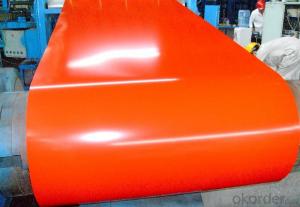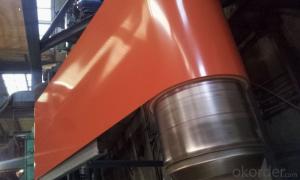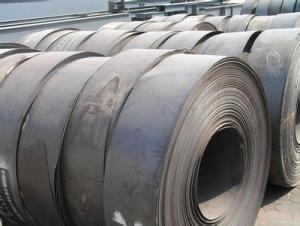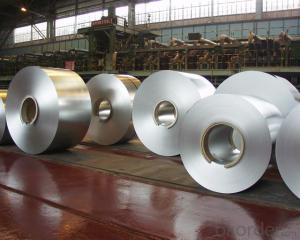High grade hot rolled narrow strip steel
- Loading Port:
- Tianjin
- Payment Terms:
- TT OR LC
- Min Order Qty:
- 300 m.t.
- Supply Capability:
- 5000 m.t./month
OKorder Service Pledge
OKorder Financial Service
You Might Also Like
Definition
Edit
Strip steel
The strip generally supplied in rolls, has the advantages of high size precision,good surface quality, easy processing, material saving etc.. With the same steel plate, strip by strip material is divided into ordinary and high quality strip steel two categories; according to the manufacturing method of hot rolled strip,cold rolled strip two.
2 scope of application
Edit
Steel is widely used in the production of welded steel pipe as blank, cold-formed steel, manufacturing bicycle frame, wheels, clamps, washer, spring film,saw blade, metal products and blade etc..
Cold-formed steel
In broadband steel
The 3 process
Edit
The production process of cold rolled strip steel is generally: picklinglubrication, rolling, process, anneal and flat, cutting, packaging.
Cold rolled strip steel pickling rolling process: -- -- -- -- the size of synchronousrolling annealing lubricating antirust oil length -- -- -- flat polished package
Hot strip rolling heating furnace dephosphorization machine: -- -- -- --phosphorus removal roughing mill machine finishing mill surface quality inspection instrument -- -- -- -- layer cold coiler bundling machine -- number spraying machine -- volume base slab
The production process of hot rolling strip steel: first in the heating furnace of increasing the temperature to the desired temperature of rolling, and then oxidized to tin machine generated on the slab roller into the roughingphosphorus removal treatment, then enter the width and thickness of striproughing rolling unit rolling, iron oxide by roller conveying to phosphorus on the strip surface finishing machine produce processing, enter the width and thickness of strip finishing rolling unit for more precision rolling, strip by rollerby layer on the surface temperature of cold roll strictly control take before and after, enters the coiler for steel coil finally bundling, spraying number into thevolume storage packaging.
4 Market
Edit
In May 20th Shengfang steel prices down. According to the data Chineseindustry insight network show: Hebei forward, Sheng Bao, Bazhou Xinya, the new crown made 2.5* (232-355) steel price is 3400 yuan (ton price, the same below), down 50 yuan more than last Friday.
Influenced by Tangshan last week, small narrow billet prices, Saturday (18 days) in Shengfang area with steel mills have lowered the ex factory price. The price decline, turnover performance in general, opened today manufacturersoffer temporary stability. In addition, the Tangshan area steel prices also have lowered, 355mm strip retail pricing million in 3320-3350, with the local price difference between 50-80 yuan, relatively reasonable.
Today Tangshan small narrow band market prices show small to rise, and the futures, electronic disk also rise, but the rise of strength are insufficient. At present, the overall trend of steel spot market downturn, but the steel market is restricted by the supply pressure, the market price is the emergence of the continuing rise in prices. And will soon enter the consumer off-season, terminaldemand release rate has slowed down, expected short-term local steel marketprice is still dominated by the shock consolidation.
5 Classification
Edit
Hot rolled strip
1, hot rolled ordinary carbon structural steel (GB3524-83)
Strip steel
Hot rolled plain carbon steel with ordinary carbon structural steel as material,made of 1.80-6.00mm hot rolled strip thickness, width of 50-1200mm.
(1) the main purposes
Mainly used for cold rolling billet, cold-formed steel billet, welded steel pipebillet and bicycle, hardware products manufacturing.
(2) grade and chemical composition of materials
Standards and grades
National standard
Quite foreign standard
Function and use
Material categories
The implementation of standards
Grade
Standard No.
Grade
Suitable for manufacturing of cold forming parts
Low carbon steel coil
Q/BQB302
SPHC
JISG3131
SPHC
SPHD
SPHD
SPHE
SPHE
SAE1006/SAE1008
SAE1006/SAE1008
XG180IF/200IF
XG180IF/200IF
Steel for general structure
GB/T912-1989
Q195
JISG3101
SS330
For general construction of buildings, bridges, ships, vehicles, etc.
Q235B
SS400
SS400
SS490
ASTMA36
SS540
(3) the mechanical properties
The nominal thickness
The yield strength (Mpa)
Tensile strength (Mpa)
Elongation of A50mm%
The 180 degree bend test
>1.5-2.5
Less than or equal to 290
More than 310
More than 38
D=0a
>2.5-3.0
Less than or equal to 290
More than 300
More than 38
D=0a
>3.0-4.0
Less than or equal to 290
More than 300
More than 40
D=1/2a
Use of hot-rolled steel 2, bicycle (GB3645-89)
Bicycle for hot rolled wide strip steel in carbon steel and low alloy steel asmaterial, made of 1.8-8.0mm strip steel thickness after hot rolling, the strip width can reach 1300mm.
(1) the main uses special for bicycle manufacturing materials.
(2) grade and chemical composition of materials
(3) the mechanical properties
(4) strip (board) size
The thickness of the steel plate strip thickness 1.8-6.0mm, 7, 8.0mm.
Strip (board) width: rimming steel is less than or equal to 1300mm (a=2.0-6.0)
Killed steel is less than or equal to 1250mm (a = 3)
Less than or equal to 1300mm (a = 3)
The length of the plate, steel coil diameter 760mm, 4-6m plate.
Hot rolled strip with 3, bicycle (GB3647-89)
(1) the main purposes
Bicycle designed for the manufacture of hot rolled strip of bicycle and the chain, also can be used for cold rolled and welded pipe blank blank.
(2) grade and chemical composition of materials
(3) the mechanical properties
(4) the specification of strip
Bicycles are generally used for hot rolled strip steel strip thickness of 1.8-8.0mm, width of 60-250mm.
Hot rolled strip with 4, pressure vessel (GB5681-85)
(1) the main purposes
Used in the manufacture of low pressure vessel.
(2) grade and chemical composition of materials
(3) the mechanical properties
(4) the specification of strip and production unit
Pressure vessel is generally used for hot rolled strip steel strip thickness of 4mm, width of 80mm double length, length of not less than 70m (volume).
Cold rolling of strip
(1) the main purposes
Cold-rolled carbon steel for the manufacture of bicycles, sewing machines,agricultural machinery and other accessories and hardware products.
(2) grade and chemical composition of materials
Grade
Supply standard
Supply size
Use
SPCC
Q195
Q235-B
GB/T912
GB/T3274
Width
Mm
Thickness
Mm
Widely used in engineering machinery, transportation machinery, construction machinery, hoisting machinery。
- Q:What are the different surface treatments for steel strips to improve hardness?
- There are several surface treatments available to enhance the hardness of steel strips. Some commonly used methods include case hardening, nitriding, carburizing, and induction hardening. Each technique involves different processes and chemicals to introduce carbon or nitrogen into the surface layer of the steel, creating a hardened layer that improves its overall hardness and wear resistance. The specific treatment chosen depends on the desired hardness level, the application requirements, and the budget constraints.
- Q:What are the common packaging materials for steel strips?
- The common packaging materials for steel strips include wooden crates, cardboard boxes, and metal or plastic strapping to secure and protect the strips during transportation and storage.
- Q:How do steel strips perform in noise reduction applications?
- Steel strips perform well in noise reduction applications due to their high density and rigidity. They effectively absorb and dampen sound waves, reducing the transmission of noise. Additionally, their durability and resistance to corrosion make them suitable for long-term use in various noise control settings.
- Q:How do steel strips perform in frictional applications?
- Steel strips perform exceptionally well in frictional applications. Due to their high strength and durability, they can withstand heavy loads and resist wear and tear over time. Their smooth surface and low coefficient of friction ensure efficient and consistent performance, making them ideal for applications such as braking systems, clutch plates, and conveyor belts. Additionally, steel strips are known for their excellent heat dissipation properties, which helps to minimize overheating and maintain optimal performance even under intense frictional conditions.
- Q:What is the fatigue resistance of steel strips?
- The ability of steel strips to withstand repeated stress or strain without failing is known as their fatigue resistance. Steel strips are renowned for their high fatigue resistance, which makes them suitable for various applications involving constant or cyclic loading. Several factors, including the composition, microstructure, and surface condition of the steel, contribute to the fatigue resistance of steel strips. Additionally, the fatigue resistance is also influenced by factors such as the magnitude, frequency, and duration of the cyclic loading. Steel strips are usually designed to have a high fatigue limit, allowing them to endure a large number of stress cycles without failing. This characteristic makes steel strips highly desirable in industries where fatigue failure is a concern, such as automotive, aerospace, construction, and manufacturing. By employing proper design, manufacturing processes, and material selection, steel strips can achieve exceptional fatigue resistance, ensuring their long-term performance and reliability in demanding applications.
- Q:Can steel strips be used in construction?
- Yes, steel strips can be used in construction. They are often used as structural components in various applications such as framing, roofing, reinforcing concrete, and creating support systems. Steel strips offer strength, durability, and versatility, making them a popular choice in the construction industry.
- Q:How are steel strips processed for bonding?
- Steel strips are processed for bonding through a series of steps that involve surface preparation, adhesive application, and curing. The first step in the process is usually cleaning the steel strips to remove any dirt, oil, or other contaminants that may be present on the surface. This can be done through methods such as solvent cleaning, degreasing, or sandblasting. Once the surface is clean, it is then typically treated to enhance its bonding properties. This can involve roughening the surface through processes like sanding or etching, which create a rough texture that promotes adhesion. Alternatively, a surface treatment such as plasma or chemical treatment may be applied to modify the surface chemistry and improve bonding. After the surface preparation, an adhesive is applied to the steel strips. The adhesive chosen will depend on the specific requirements of the bonding application, such as the type of steel being used, the desired bond strength, and the environmental conditions the bond will be exposed to. The adhesive can be applied using various methods such as spraying, brushing, or roller coating. Once the adhesive is applied, the steel strips are brought together and pressure is applied to ensure proper contact and bonding. This can be done through techniques like clamping, using rollers, or applying mechanical pressure. Some bonding processes may also involve heating the adhesive to activate its curing properties. Finally, the adhesive is allowed to cure, which is the process of the adhesive hardening and reaching its maximum strength. The curing time will depend on the type of adhesive used and can range from minutes to hours or even days. During this time, it is crucial to ensure that the steel strips remain in the correct position and under the required conditions (e.g. temperature, humidity) for optimal bonding. In summary, steel strips are processed for bonding by cleaning and treating the surface, applying an adhesive, bringing the strips together under pressure, and allowing the adhesive to cure. This process ensures a strong and durable bond between the steel strips, suitable for various applications in industries such as construction, automotive, and manufacturing.
- Q:What are the safety considerations when handling steel strips?
- When handling steel strips, there are several important safety considerations to keep in mind. Firstly, it is crucial to wear appropriate personal protective equipment (PPE) such as gloves and safety glasses to protect against cuts and potential flying debris. Additionally, steel strips can be heavy and sharp, so proper lifting techniques should be used to prevent back injuries. Another safety consideration is the potential for the steel strips to have sharp edges or burrs. It is important to inspect the strips for any sharp or jagged edges before handling them to avoid cuts or punctures. If any defects are found, the strips should be properly deburred or filed down to remove any hazards. Furthermore, steel strips can be slippery, especially if they are coated or have oils on them. Therefore, it is crucial to have a clean and dry working area to prevent slips and falls. If necessary, anti-slip mats or appropriate footwear should be used to enhance traction and stability. Lastly, when handling steel strips, it is important to be mindful of the potential hazards associated with their storage and transportation. Strips should be stored in a secure and organized manner to prevent them from falling or rolling onto workers. Additionally, when transporting steel strips, they should be properly secured to prevent movement or shifting during transit. Overall, the safety considerations when handling steel strips revolve around wearing appropriate PPE, using proper lifting techniques, inspecting for sharp edges, maintaining a clean working area, and ensuring secure storage and transportation. By following these safety measures, the risk of injuries and accidents associated with handling steel strips can be significantly reduced.
- Q:Are steel strips suitable for roofing or cladding?
- Yes, steel strips are suitable for roofing and cladding due to their durability, strength, and resistance to weather conditions, making them a reliable and long-lasting option for protecting buildings.
- Q:How are steel strips coated with protective coatings?
- The process of steel coil coating enables the application of protective coatings onto steel strips, enhancing their durability and resistance to damage caused by corrosion, abrasion, and other factors. To begin the coating process, the steel strip is thoroughly cleaned and prepared. This step is crucial in order to eliminate any contaminants like dirt, oil, or rust that may hinder the adherence of the protective coating. The cleaning process can involve mechanical techniques, chemical treatments, or a combination of both. Once the steel strip is clean, the protective material is applied. Different methods can be used for this purpose, including roller coating, spray coating, or dip coating. Roller coating ensures an even application of the coating material by passing the steel strip through a series of rollers. Spray coating, on the other hand, involves using a high-pressure spray gun to apply the coating in a controlled manner. Dip coating entails immersing the steel strip into a bath of the coating material to achieve full coverage. After the coating is applied, the steel strip is typically cured or dried to promote proper adherence and the formation of a durable protective layer. This can be accomplished through various methods such as oven curing, infrared heating, or air drying, depending on the specific coating material used. The choice of protective coating material depends on the intended application and the desired level of protection. Organic coatings like paints, lacquers, or polymers, as well as inorganic coatings like metallic or ceramic coatings, are commonly used to protect steel strips. Each type of coating offers distinct properties and advantages, such as corrosion resistance, weatherability, scratch resistance, or chemical resistance. In conclusion, the process of coating steel strips involves cleaning and preparing the surface, applying the coating material using techniques such as roller coating, spray coating, or dip coating, and then curing or drying the coating to ensure its durability. The selection of the coating material depends on the desired level of protection and the specific application.
1. Manufacturer Overview |
|
|---|---|
| Location | |
| Year Established | |
| Annual Output Value | |
| Main Markets | |
| Company Certifications | |
2. Manufacturer Certificates |
|
|---|---|
| a) Certification Name | |
| Range | |
| Reference | |
| Validity Period | |
3. Manufacturer Capability |
|
|---|---|
| a)Trade Capacity | |
| Nearest Port | |
| Export Percentage | |
| No.of Employees in Trade Department | |
| Language Spoken: | |
| b)Factory Information | |
| Factory Size: | |
| No. of Production Lines | |
| Contract Manufacturing | |
| Product Price Range | |
Send your message to us
High grade hot rolled narrow strip steel
- Loading Port:
- Tianjin
- Payment Terms:
- TT OR LC
- Min Order Qty:
- 300 m.t.
- Supply Capability:
- 5000 m.t./month
OKorder Service Pledge
OKorder Financial Service
Similar products
New products
Hot products
Related keywords




























